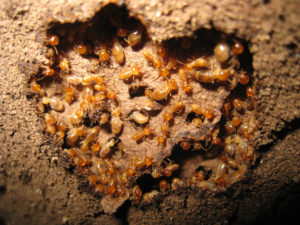Subterranean Termites in Marion, Mount Gilead, Delaware, OH and Surrounding Areas
 Subterranean termites live in underground colonies or in moist secluded areas above ground that can contain up to 2 million members. They build distinctive “mud tubes” to gain access to food sources and to protect themselves from open air.
Subterranean termites live in underground colonies or in moist secluded areas above ground that can contain up to 2 million members. They build distinctive “mud tubes” to gain access to food sources and to protect themselves from open air.
- Termite colonies are organized into castes depending on tasks — workers, soldiers and reproductives. The characteristics of a subterranean termite are dependent on the termite’s role in the colony. Cream-colored Worker subterranean termites are 1/8 to 3/8’s of an inch in length. Soldier subterranean termites are of a similar body length, but are distinguished by their powerful mandibles. Soldier termites have cream-colored bodies and brown heads. Reproductive subterranean termites are approximately one inch long. In larger nest, a queen and king may live for 15 years, while the queen laying up to one egg every 15 seconds for most of her life. They Cause serious damage to structures often long before they are discovered — more than $1.5 billion in property damage a year to over 600,000 homes in the U.S.
Pest Facts:
Color: Creamy brown
Legs: Six
Shape: Long, narrow, oval
Size: 1/8 inches Termite Stages
Antennae: yes
Flying: Yes
Region: All 50 States
Photos from National Pest Management approved to use:
- Termite Stages
Habits
Subterranean termites live underground and build tunnels, referred to as mud tubes, to reach food sources. Like other termite species, they feed on products containing cellulose such as wood, paper, even books. Subterranean termites swarm in the spring — groups of reproductive termites go off to start new colonies.
Habitat
Subterranean termites need contact with the soil to survive and live underground. They can build tunnels through cracks in concrete.
Threats
Subterranean termites are by far the most destructive species. They can collapse a building entirely, meaning possible financial ruin for a homeowner. The hard, saw-toothed jaws of termites work like shears and are able to bite off extremely small fragments of wood, one piece at a time.
Prevention
Avoid water accumulation near your home’s foundation. Divert water away with properly functioning downspouts, gutters and splash blocks. Reduce humidity in crawl spaces with proper ventilation. Never bury wood scraps or waste lumber in the yard. Most importantly, eliminate wood contact with the soil. Maintain a one-inch gap between the soil and wood portions of the building.
Treatment: There are several methods of treatment available. Property type and location determine recommendations.
